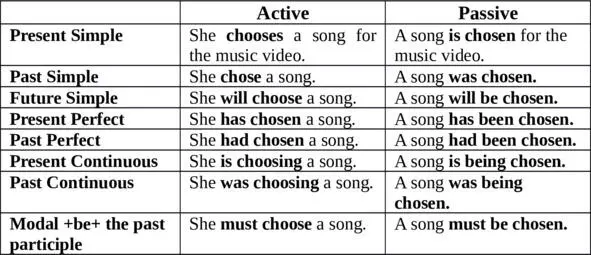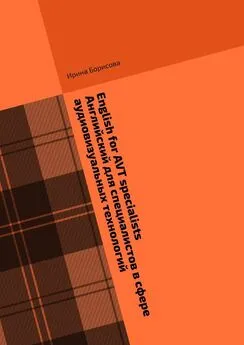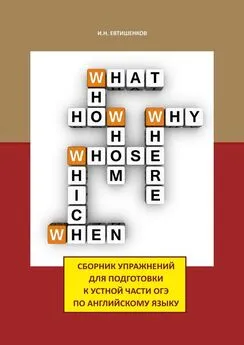Ирина Борисова - English for AVT specialists. Английский для специалистов в сфере аудиовизуальных технологий. Сборник текстов и упражнений по английскому языку
- Название:English for AVT specialists. Английский для специалистов в сфере аудиовизуальных технологий. Сборник текстов и упражнений по английскому языку
- Автор:
- Жанр:
- Издательство:неизвестно
- Год:неизвестен
- ISBN:9785449366627
- Рейтинг:
- Избранное:Добавить в избранное
-
Отзывы:
-
Ваша оценка:
Ирина Борисова - English for AVT specialists. Английский для специалистов в сфере аудиовизуальных технологий. Сборник текстов и упражнений по английскому языку краткое содержание
English for AVT specialists. Английский для специалистов в сфере аудиовизуальных технологий. Сборник текстов и упражнений по английскому языку - читать онлайн бесплатно ознакомительный отрывок
Интервал:
Закладка:
Grammar revision: active and passive voice
We use the active voice to say what the subject of the sentence does:
In the 1970s, Dolby professionals made an introduction of a separate «boom» subwoofer channel, or so called the «LFE channel».
We use the passive voice to say that something happens to the subject:
However, mastering these technologies was limited by certain economic factors.
Here is some more information about the passive voice.
We use a passive verb
1) when what or who causes the action is unimportant, unknown or obvious from the context:
Two new studios have been built recently.
2) to sound more formal or more polite:
The letter hasn’t been sent. ( Instead of: You haven’t sent the mail.)
3) when the action itself is more important than who or what does it (in technological processes, reports, newspaper headings, manuals, instructions, regulations etc.):
Dolby Stereo Digital was first encoded on the 1992 film Batman Returns.
4) to put more emphasis on the agent:
The new laboratory will be opened by the company president.
We form the passive voice with the verb to be and the past participle of the main verb:
be (is/was/have beenetc.) + the past participle (made/ washed/doneetc.)

10. Fill the gaps in the sentences with the verbs given. Use them in the correct tense either in the active or in passive voice.
Remain, influence, introduce, limit, evolve, fail, beset, receive, increase.
1) Some of these technological advances finally _______ into meaningful improvements.
2) The cinematic systems of that time were unable to produce loud low frequency signals without clipping, that’s why a subwoofer channel (also called the «LFE channel») _____ ______ by Dolby Laboratories.
3) Though the pioneering idea of the Quad installation______, it led to further exploration into consumer surround sound.
4) The acceptance of new technologies, especially since the expansion of television was making serious inroads into the profit margins of the cinematograph, _____ ______ by certain economic factors.
5) Until the early 1950s the dominance of the movie was obvious and it _______ the main source of public entertainment.
6) By the late 1970s, specialists at Dolby Laboratories started their development of the Dolby Stereo system, whereby information _____ _____ by three front speakers and a few rear speakers.
7) The invention of the «boom» subwoofer channel had an added advantage: it effectively ______ the dynamic range of theatrical installations.
8) The growing popularity of television certainly _______ the development of the film industry.
9) The analog four-channel arrangement Quad turned out to _____ _____ by a multitude of economic, technical, and aesthetic problems that eventually led to its failure.
Vocabulary work: adjectives and adverbs
A lot of adverbs are made from adjectives by adding —ly:
Quick-quickly, careful-carefully
Note that not all words, which end in —ly, are adverbs. There are some adjectives that have the —ly ending, too:
Friendly, lively, etc.
11. Transform the adjectives into adverbs using the pattern given below. Work out the meaning of the unknown words from the text.
Example:amazing – amazingly
Certain, real, meaningful, desperate, eventual, significant, great, progressive, complete, optical, separate, effective, approximate, sufficient, definite.
Use the words in sentences of your own.
TALKING AND DISCUSSING POINT
12. Make a plan to the article using your notes in exercise 5.
13. Write a key sentence for each point of your plan.
14. Make a summary of the article adding a few more sentences to each point of your plan. Use the key words.
15. Answer the «What do you think» questions.
1) Why did television threaten the cinema in the early 1950s?
2) Which of the two opponents —the movie or the television – has eventually won?
3) Why 3D glasses are called a gimmick in the text? What other «gimmicks» used to attract audience can you name?
4) Are there any economic, technical and aesthetic problems in the sphere of the sound production nowadays?
5) What technological advances in the surround sound will be achieved in the nearest future?
WRITING
16. Write a commentary that contains two arguments for and two arguments against the statement: «Society cannot do without technologies.» Write 120—180 words.
17. Write an essay commenting on the following statement (State Exam Writing).
Work is the most important thing in life.
Do you agree with the statement? What is your point of view?
Write 200—250 words.
Use the plan below:
– make an introduction (state the problem)
– express your personal opinion giving 2—3 reasons to support it
– express an opposing opinion giving 1—2 reasons for it
– explain why you do not agree with the opposing opinion
– write a conclusion restating your position
CHECK POINT
18. Complete the sentences choosing from the words in brackets. Use the information you have learnt from Unit 1, Part 2.
1) Though some advances introduced by the film studios in the 1950s were just … (gimmicks, failures, digital schemes) to attract viewers, other ones eventually developed into significant improvements.
2) The stereo recordings of a … (child, ping – pong ball, football) bouncing between speakers encouraged the growth of the modern consumer surround sound.
3) In the early 1970s, the … (research, experiment, record) into the consumer surround sound led to an analog four – channel configuration called Quad.
4) The «LFE channel» invented by Dolby specialists in the 1970s really (decreased, made, increased) dynamic range in cinematic configurations.
5) In the name «5.1» the». 1» stands for the LFE channel because it carries only approximately (one-third, one-fifth, one-tenth) of the frequency range of the other channels.
Text 3. Part 3. The 1990s – today
PRE-READING
1. Guess the meaning of the following words from the text.
Organization, information, communication, optimum, allocation, classical, material, effect, result, document, accompany, professional, standard, factual, industry, recommendation, modern, mix, method, equally, film, production, role, studio, number, laser, disc, encoded, industry, theater, mass, public, manufacturer, multitrack, component, console, monitor, integral, automobile, gadget, content, compromise.
2. Think of some more words or phrases to supplement the list above.
3. Think of some achievements in the sphere of sound production that have come in sight over the past 30 years. How have they influenced ordinary customers’ lives?
SUBJECT AND LANGUAGE STUDY
Reading
4. Skim the text. Are the following statements true or false?
1) The ITU carried out research to determine the optimal position of the speaker in a 5.1 system.
2) The ITU document «Recommendation for Multichannel Stereophonic Sound System With and Without Accompanying Picture» came out in 1990.
3) In the 1990s, at least five major film digital surround sound encoding formats made appearance.
4) The DVD appeared in the middle 90s.
5) Using high definition formats to allocate content surround sound producers can do without clipping and sonic compromise.
In the early 1990s, the organization that is responsible for information and communication technologies throughout the world known as the ITU (International Telecommunications Union) conducted research aimed at determining the optimum speaker allocation in a 5.1 arrangement. The research was based mainly on the classical music as source material and the rear speakers were described only as «effects» or «ambience» speakers. As a result, a document entitled «Recommendation for Multichannel Stereophonic Sound System With and Without Accompanying Picture» was issued in 1994. Actually, professionals widely accepted it as a factual industry standard. The ITU Recommendation, however, may not be considered to be perfectly suitable for many music applications, since it came out long before the appearance of modern surround sound mixing methods which treat all the five speakers as equally important.
The 1990s were featured by development and proliferation of digital audio systems. Employment of digital audio for film production was practically becoming a commonplace; the role of digital audio workstations (DAWs) in recording studios all over the world was getting more and more important. There were plans for creating a digital television broadcast system that gradually would mature into High Definition Television (HDTV). Researchers made a focus on embedding surround sound into the second-generation digital audio systems that were growing in number successfully. In that period, at least three major film digital surround sound encoding formats saw the light of the day. These were Sony SDDS TM, Dolby RDigital TM(technically called «AC-3»), and DTS TM. Moreover, the introduction of laser discs (with their ability to carry encoded surround sound) greatly encouraged advance of a nascent industry known as home theater. People began to add supplementary subwoofers and surround speakers to their home listening sets.
In the mid – 1990s, the DVD was released. It provided the mass public with a medium delivering surround sound right into the comfort of their homes. Audio manufacturers started offering different surround sound tools that whetted the consumer’s appetite for high quality digital multitrack systems and a variety of components such as surround – ready mixing consoles, monitoring units and effects devices have found their way into people’s living rooms as well as into professional studios.
Today, surrounds sound is an integral part of home theater and has also made its appearance in the automobile. Multichannel audio is used in the digital television broadcast, gaming gadgets, and in the Internet (through streaming codecs). High definition formats (like SA – CD Multichannel and DVD – Audio) enable the surround sound producer to allocate content without clipping and sonic compromise. This makes their advent one of the most remarkable achievements in the history of the sound production.
Essential glossary
• aimed at – нацеленный на
• allocation – расположение, расстановка
• source – источник
• ambience – окружение, обстановка, среда
• suitable – подходящий, соответствующий
• application – приложение, (прикладная) система
• proliferation – распространение
Читать дальшеИнтервал:
Закладка:










